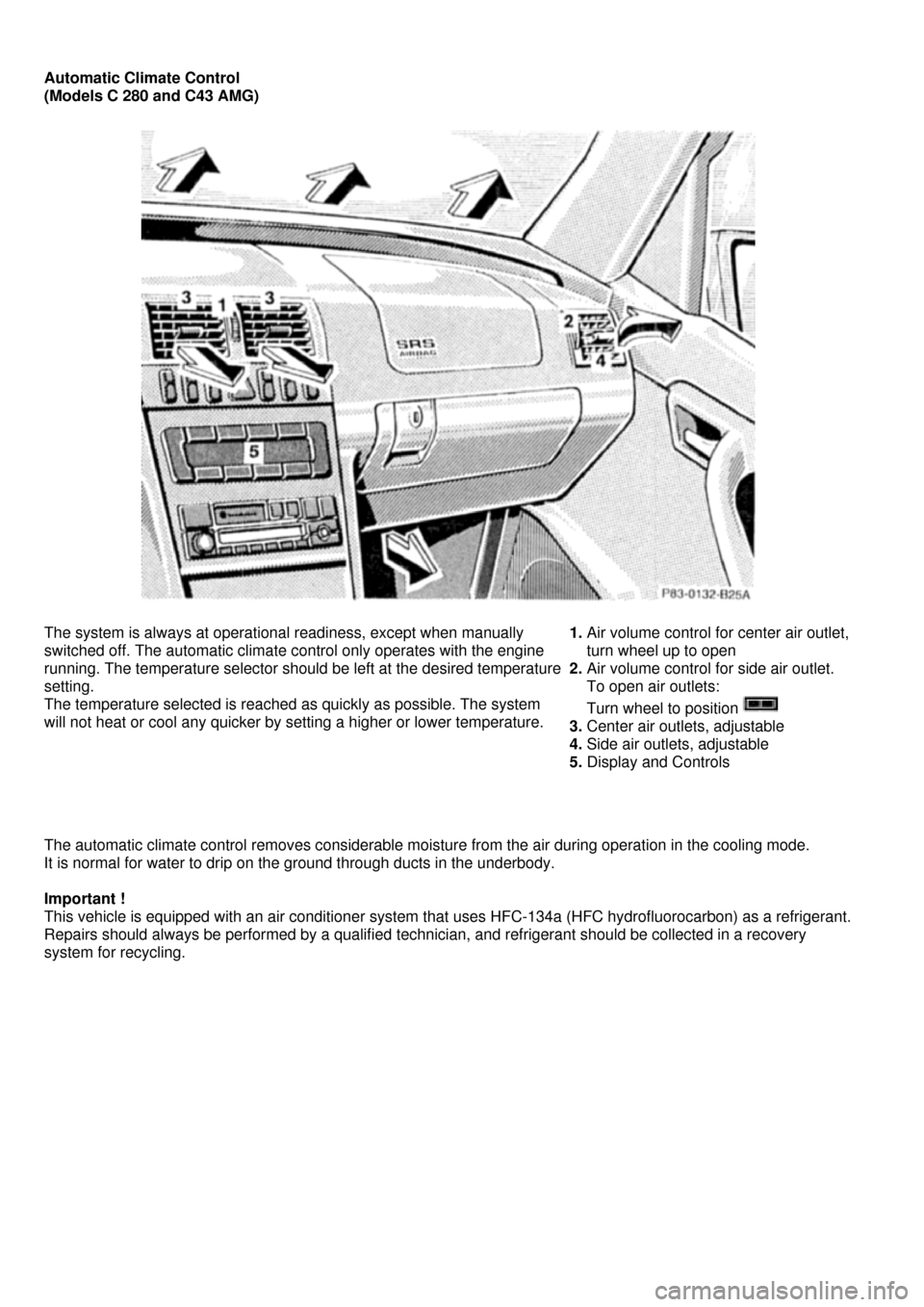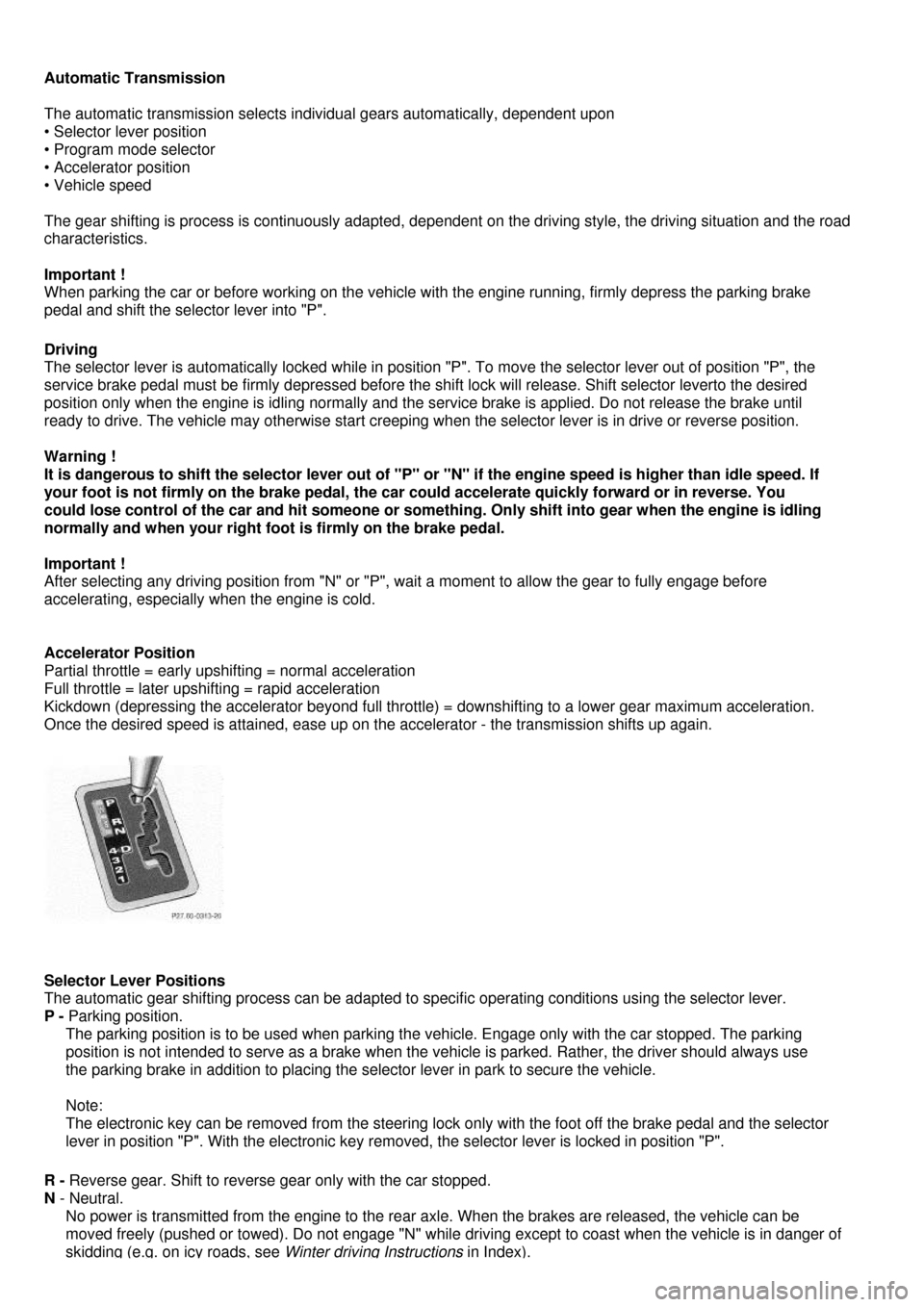Ran out MERCEDES-BENZ C-Class 2000 W202 Owner's Manual
[x] Cancel search | Manufacturer: MERCEDES-BENZ, Model Year: 2000, Model line: C-Class, Model: MERCEDES-BENZ C-Class 2000 W202Pages: 130, PDF Size: 2.43 MB
Page 10 of 130

Tire Speed Rating
Model C 43 AMG only: This vehicle is factory equipped with "Z"-rated tires. All other models: These vehicles are factory
equipped with "H"-rated tires, which have a European spee d rating of 130 mph (210 km/h). An electronic speed limiter
prevents your vehicle from exceeding the speed rating. Despit e the tire rating, local speed limits should be obeyed. Use
prudent driving speeds appropriate to prevailing conditions.
Warning !
Even when permitted by law, never operate a vehicle at speeds greater than the maximum speed rating of the
tires. Exceeding the maximum speed for which tires are rated can lead to sudden tire failure causing loss of
vehicle control and resulting in personal injury and possible death.
Parking
Warning !
To reduce the risk of personal injury as a result of vehicle movement, before turning off the engine
and leaving the vehicle always:
1. Keep right foot on brake pedal.
2. Firmly depress parking brake pedal.
3. Move the selector lever to position "P".
4. Slowly release brake pedal.
5. Turn front wheels towards the road curb.
6. Turn the key to steering lock position 0 and remove.
7. Take the electronic key and lock vehicle when leaving.
Important !
It is advisable to set the parking brake whenever parking or leaving the vehicle. In addition, move selector lever
to position "P". When parking on hills, always set the parking brake.
Winter Driving Instructions
The most important rule for slippery or icy roads is to driv e sensibly and to avoid abrupt acceleration, braking and steering
maneuvers. Do not use the cruise control system under such conditions.
When the vehicle is in danger of skidding, move selector le ver to position "N". Try to keep the vehicle under control by
corrective steering action. Road salts and chem icals can adversely affect braking efficiency.
Increased pedal force may become necessary to produce t he normal brake effect. We therefore recommend depressing
the brake pedal periodically when travelling at length on salt-strewn roads. This can bring road salt impaired
braking efficiency back to normal. A prerequisite is, however, that this is done without endangering other drivers on the
road. If the vehicle is parked after being driven on salt treated roads, the braking efficiency should be tested as soon as
possible after driving is resumed while observi ng the safety rules in the previous paragraph.
Warning !
If the vehicle becomes stuck in snow, make sure that snow is kept clear of the exhaust pipe and from
around the vehicle with engine running. Otherwise, deadly carbon monoxide (CO) gases may enter
vehicle interior resulting in unconsciousness and death. To assure sufficient fresh air ventilation, open
a window slightly on the side of the car that is out of the wind.
Deep Water
Caution !
Do riot drive through flooded areas or water of unknown dept h. If you must drive through deep water, drive slowly to
prevent water from entering the engine compartment or being ingested by the air intake, possibly causing damage to
electrical components or wiring, to engine or transmission t hat is not covered by the Mercedes-Benz Limited Warranty.
Passenger Compartment
Warning !
Always fasten items being carried as securely as possible. In an accident, during hard braking or sudden
maneuvers, loose items will be thrown around inside the vehicle, and cause injury to vehicle occupants unless
the items are securely fastened in the vehicle. The trunk is the preferred place to carry objects.
Page 14 of 130

Air Recirculation
This mode can be selected to temporarily reduce the entry of annoying odours or dust from vehicle's interior.
Outside air is not supplied to the car's interior.
To select, press button.
To cancel, press button again.
The system will automatically switch from recirculated air to fresh air
• after approx. 5 minutes at outside temperatures below approx. 40°F (5°C),
• after approx. 30 minutes, at outside temperatures above approx. 40°F (5°C),
• after approx. 5 minutes, if button is pressed.
At hight ouside temperatures, the system automatically engages the recirculated air mode for approx.
30 minutes, thereby increasing the cooling capacity performance. Press button again to extend the recirculated
air mode.
Residual Engine Heat Utilization
With the engine switched off, it is possible to continue heating the interior for a short while.
Air volume is controlled automatically
To select:
Turn electronic key in steering lock to position 1 or 0 or remove . Close air outlet in rear passenger compartment.
Press button. Indicator lamp in the button lights up.
This function selection will not activate if the battery charge level is insufficient.
To cancel:
Press button. Indicator lamp in the button goes out
The system will automatically shut off
• if you turn key in steering lock to position 2,
• after approx. 30 minutes,
• if the battery voltage drops.
Dust Filter
Nearly all dust particles and pollen are filtered out before outside air enters the passenger compartment through the
air distribution system.
Note:
Keep the air intake grille in front of windshield free of snow and debris.
Important !
This vehicle is equipped with an air conditioner system that uses R-134a (HFC: hydrofluorocarbon)
as a refrigerant. Repairs should always be performed by a qualified technician, and refrigerant
should be collected in a recovery system for recycling.
Page 15 of 130

Automatic Climate Control
(Models C 280 and C43 AMG)
The system is always at operational readiness, except when manually
switched off. The automatic climate control only operates with the engine
running. The temperature selector should be left at the desired temperature
setting.
The temperature selected is reached as quickly as possible. The system
will not heat or cool any quicker by setting a higher or lower temperature.
1. Air volume control for center air outlet,
turn wheel up to open
2. Air volume control for side air outlet.
To open air outlets:
Turn wheel to position
3. Center air outlets, adjustable
4. Side air outlets, adjustable
5. Display and Controls
The automatic climate control removes considerable moisture from the air during operation in the cooling mode.
It is normal for water to drip on the ground through ducts in the underbody.
Important !
This vehicle is equipped with an air conditioner system that uses HFC-134a (HFC hydrofluorocarbon) as a refrigerant.
Repairs should always be performed by a qualified technician, and refrigerant should be collected in a recovery
system for recycling.
Page 19 of 130

Car Keys
Included with your vehicle are:
• 2 electronic main keys with integrated radio frequency and infrared
remote controls plus slide out and removable mechanical key.
• 1 electronic reserve key without remote control functions, plus
removable mechanical key.
Warning !
When leaving the vehicle always remove the electronic key from the steering lock, and
Lock your vehicle. Do not leave children unattended in the vehicle, or with access to an
unlocked vehicle. Unsupervised use of vehicle equipment may cause serious personal injury.
Electronic main key with integrated radio frequency and infrared remote control, plus
slide out and removable mechanical key. The remote control (1) operates all locks on the car.
The mechanical key (2) works only in the driver's door, trunk, and storage compartment locks.
The mechanical key (2) can be removed by sliding it out of the remote control. To do so, move
lock (3) in direction of arrow and slide the mechanical key (2) in direction of arrow (5).
In the case of using the mechanical key for lock operations, it can be extended outward. To do so,
move lock (3) in direction of arrow, slide the mechanical key (2) in direction of arrow (4) until it locks in
place. The remote control transmitter is located in the electronic main key. The infrared receivers are
located in the front door handles.
Note:
Remove the mechanical key from the electronic main key when using valet parking service. To prevent
access to trunk or storage compartments lock them separately.
Electronic reserve key without remote control functions,
plus removable mechanical key.
The electronic reserve key (1) works only in the steering lock.
The mechanical key (2) works only in the driver's door, trunk, and
storage compartment locks. To use the mechanical key (2),
remove it from its electronic reserve key (1).
Note:
We recommend that you carry the electronic reserve key plus mechanical key with you and keep it in a
safe place (e.g. your wallet) so that it is always handy. Never leave the electronic reserve key in the vehicle.
Obtaining Replacement Keys
Your vehicle is equipped with a theft deterrent locking system requiring a special key manufacturing process.
For security reasons, replacement keys can only be obtained from your authorized Mercedes-Benz dealer.
Page 23 of 130

Opening the Trunk
A minimum height clearance of 5.9 ft ( 1.8 m) is required to open the trunk lid.
Press transmit button until trunk lid is open.
Important !
Do not place remote control in trunk since trunk is locked again when closing the lid.
Note:
If the trunk was previously locked separately, it will remain locked (see Index).
Opening and Closing Windows and Sliding/Pop-Up Roof from Outside
Aim transmitter eye (5) of remote control at door receivers (6 or 7).
To open:
Continue to press transmit button after unlocking car
The windows and sliding/pop-up roof begin to open after approx. 1 second. To interrupt opening
procedure, release button.
To close:
Continue to press transmit button after locking car
The windows and sliding/pop-up roof begin to close after approx. 1 second. To interrupt closing
procedure, release button.
Warning !
Never operate the windows or sliding/pop-up roof if there is the possibility of anyone being
harmed by the opening or closing procedure.
In case the procedure causes potential danger, the procedure can be immediately halted by
releasing the remote control button. To reverse direction of movement press for opening
or for closing.
Note:
If the windows and sliding/ pop-up roof cannot be operated automatically by pressing the transmit
button of the remote control then it may be necessary to change the batteries in the transmitter
(if ok, battery check lamp in transmitter will light briefly when transmitting), or to synchronize the
electronic main key, see Synchronizing remote Control in Index.
Page 40 of 130

BabySmart™ Airbag Deactivation System
Special child seats, designed for use with the Mercedes-Benz system and available at any
authorized Mercedes-Benz dealer are required for use with the BabySmart™ airbag deactivation
system. With the special child seat properly installed, the passenger front airbag will not deploy. The
indicator lamp located on the center console will be illuminated, except with electronic key
removed or in steering lock position 0. The system does not deactivate the door mounted side
impact airbag.
BabySmart is a trademark of Siemens Automotive Corp.
Warning !
The BabySmart™ Airbag Deactivation System will ONLY work with a special seat designed to
operate with it. It will not work with seats which are not BabySmart™ compatible. Never place
anything between seat cushion and child seat (e.g. pillow), since it reduces the effectiveness
of the deactivation system. Follow the manufacturer's instructions for installation of special
child seats. The passenger side front airbag will not deploy only if the indicator lamp
remains illuminated. Please be sure to check the indicator every time you use the special
system child seat. Should the light go out while the restraint is installed, please check
installation. If the light remains out, do not use the BabySmart™ restraint to transport
children, on the front passenger seat until the system has been repaired.
Self-Test BabySmart™ Without Special Child Seat Installed
After turning electronic key in steering lock to position 1 or 2, the indicator lamp located on
center console comes on for approx. 6 seconds.
If the lamp should not come on or is continuously lit, the system is not functioning. You must see an
authorized Mercedes-Benz dealer before using any child seat on the front passenger seat.
Page 64 of 130

Garage Door Opener
1. Integrated remote control transmitter
2. Portable remote control transmitter
Warning !
When programming a garage door opener, the door moves up or down. When programming or operating
the remote control make sure there is no possibility of anyone being harmed by the moving door.
The built-in remote control is capable of operating up to three separately controlled objects.
Notes:
Certain types of garage door openers are incompatible with the integrated opener. If you should experience
difficulties
with programming the transmitter, contact your authorized Mercedes-Benz dealer or call Mercedes-Benz Customer
Assistance Center (in the U.S.A. only) at 1-800-FOR-MERCedes. For operation in the USA only:
This devise complies with Part 15 of the FCC Rules. Operation is subject to the following two conditions:
(1) This device may not cause harmful interference, and (2) this device must accept any interference received,
including interference that may cause undesired operation. Any unauthorized modification to this device could void
the user's
authority to operate the equipment.
Programming or reprogramming the integrated remote control:
1. Turn electronic key in steering lock to position 1 or 2.
2. Press and hold one button of the integrated remote control located on the sun visor until its control light begins to
flash at a
rate of about once a second. Continue holding down the button.
Note:
The light blinks immediately if the integrated remote control is being programmed
for the first time, or if its memory was previously erased. If you
are reprogramming a previously used button, the light will flash after
about 20 seconds.
3. Aim portable remote control transmitter at the integrated remote control transmitter to be programmed. While still
holding down the button on the transmitter on the inside rear view mirror, press down the button on you r portable
remote control transmitter, until the integrated remote control light starts to flash rapidly. This means that the
integrated transmitter has accepted the frequency and code of the portable transmitter.
4. If you wish, repeat the procedure for each remaining button.
Note:
If the garage door opener is equipped with the "rolling code feature", it needs to be trained to accept the remote
control
command. To do so, the assistance of a second person is required.
1. Locate training button (part of the opener unit in the garage).
2. Press and hold training button until training light next to the button begins to flash (in two seconds).
3. Now have the second person press and hold the previously programmed button on the integrated remote control
transmitter until the training light on the garage door opener is lit continuously (in two seconds).
4. Release and press the programmed button on the integrated remote control transmitter once again to turn off
the training light in the garage door opener.
5. Confirm the garage door operation by pressing the programmed button on the integrated remote control
transmitter.
Page 67 of 130

Drinking and Driving
Warning !
Drinking and driving can be a very dangerous combination. Even a small amount of alcohol or drugs can
affect your reflexes, perceptions and judgement. The possibility of a serious or even fatal accident is
sharply increased when you drink and drive. Please don't drink and drive or allow anyone to drive after
drinking.
Parking Brake
To engage, firmly depress parking brake pedal. When the electronic key is in steering lock position 2, the brake
warning lamp in the instrument cluster should come on brightly. To release the parking brake, pull handle on
instrument panel. The brake warning lamp in the instrument cluster should go out. A warning sounds, if you start
to drive without having released the parking brake. Also see Brake Warning Lamp Test in Index.
Driving Off
Apply the service brakes to test them briefly after driving off. Perform this procedure only when the road is clear
of other traffic. Warm up the engine smoothly. Do not place full load on the engine until the operating temperature has
been reached. When starting off on a slippery surface, do not allow one drive wheel to spin for an extended period
with the ASR or ESP switched off. Doing so may cause serious damage to the drive train which is not covered by
the Mercedes - Benz Limited Warranty.
Warning !
Keep driver's foot area clear at all times. Objects stored in this area may impair pedal movement.
Page 68 of 130

Automatic Transmission
The automatic transmission selects individual gears automatically, dependent upon
• Selector lever position
• Program mode selector
• Accelerator position
• Vehicle speed
The gear shifting is process is continuously adapted, dependent on the driving style, the driving situation and the road
characteristics.
Important !
When parking the car or before working on the vehicle with the engine running, firmly depress the parking brake
pedal and shift the selector lever into "P".
Driving
The selector lever is automatically locked while in position "P". To move the selector lever out of position "P", the
service brake pedal must be firmly depressed before the shift lock will release. Shift selector leverto the desired
position only when the engine is idling normally and the service brake is applied. Do not release the brake until
ready to drive. The vehicle may otherwise start creeping when the selector lever is in drive or reverse position.
Warning !
It is dangerous to shift the selector lever out of "P" or "N" if the engine speed is higher than idle speed. If
your foot is not firmly on the brake pedal, the car could accelerate quickly forward or in reverse. You
could lose control of the car and hit someone or something. Only shift into gear when the engine is idling
normally and when your right foot is firmly on the brake pedal.
Important !
After selecting any driving position from "N" or "P", wait a moment to allow the gear to fully engage before
accelerating, especially when the engine is cold.
Accelerator Position
Partial throttle = early upshifting = normal acceleration
Full throttle = later upshifting = rapid acceleration
Kickdown (depressing the accelerator beyond full throttle) = downshifting to a lower gear maximum acceleration.
Once the desired speed is attained, ease up on the accelerator - the transmission shifts up again.
Selector Lever Positions
The automatic gear shifting process can be adapted to specific operating conditions using the selector lever.
P - Parking position.
The parking position is to be used when parking the vehicle. Engage only with the car stopped. The parking
position is not intended to serve as a brake when the vehicle is parked. Rather, the driver should always use
the parking brake in addition to placing the selector lever in park to secure the vehicle.
Note:
The electronic key can be removed from the steering lock only with the foot off the brake pedal and the selector
lever in position "P". With the electronic key removed, the selector lever is locked in position "P".
R - Reverse gear. Shift to reverse gear only with the car stopped.
N - Neutral.
No power is transmitted from the engine to the rear axle. When the brakes are released, the vehicle can be
moved freely (pushed or towed). Do not engage "N" while driving except to coast when the vehicle is in danger of
skidding (e.g. on icy roads, see Winter driving Instructions in Index).
Page 69 of 130

Important !
Coasting the vehicle, or driving for any other reason with selector lever in "N" can result in transmission damage
that is not covered by the Mercedes-Benz Limited Warranty.
D - The transmission automatically upshifts through 5th gear. Position "D" provides optimum driving characteristics
under all normal operating conditions.
4 - Upshift through 4th gear only.
Suitable for performance driving. To shift from position "D" to "4", push selector lever to the left.
3 - Upshift through 3rd gear only.
Suitable for moderately steep hill s. Since the transmission does not shift hi gher than 3rd gear, this gear selection
will allow use of the engine's braking power downhill.
2 - Upshift through 2nd gear only.
For driving in mountainous regions or under extreme operating conditions. This gear selection will allow use of the
engine's braking power when descending steep grades.
1 - In this position, the engine's braking effect is utilized by shifting into 1st gear.
Use this position while descending very steep or l engthy downgrades and only at speeds below 40 mph (60
km/h).
Important !
With selector lever in position "D", "4" or "3", upshifting from 1st to 2nd to 3rd gear is delayed depending on vehicle
speed and engine temperature. This allows the catalytic converter to heat up more quickly to operating temperatures.
During the brief warm-up period this delayed upshift and increased engine noise might be perceived as a malfunction.
However, neither the engine nor transmission are negatively affected by this mode of operation.
The delayed upshift is effective with vehicle speeds below 31 mph (50 km/h) at partial throttle and engine
temperatures below 95°F (35°C). To avoid overrevving the engi ne when the selector lever is moved to a lower driving
range, the transmission will not shift to a lower gear, if the engine's speed limit would be exceeded. In this case there
will be no downshift, even when the vehicle speed reaches t he engine's speed limit of that gear, e.g. by applying the
service brakes. Continue driving in the usual manner. The transmission will then shift down automatically.
To prevent the engine from laboring at low RPM when driv ing uphill gradients or with your vehicle heavily loaded, the
automatic transmission will downshift when necessary to maintain engine RPM within the best torque range.
Warning!
On slippery road surfaces, never downshift in order to obtain braking action. This could result in drive wheel
slip and reduced vehicle control. Your vehicle's AB S will not prevent this type of loss of control.
Warning !
On slippery road surfaces, never downshift in order to obtain braking action. This could result in rear
wheel slip and reduced vehicle control. Your vehicle' s ABS will not prevent this type of loss of control.
Maneuvering
To maneuver in tight areas, e.g. when pulling into a parki ng space, control the vehicle speed by gradually releasing
the
brakes. Accelerate gently and never abruptly step on the ac celerator. To rock a vehicle out of soft ground (mud or
snow),
alternately shift from forward to revers e, while applying slight partial throttle. Rocking a vehicle free in this manner
may
cause the ABS malfunction indicator lamp to come on. Turn off and restart the engine to clear the malfunction
indication.
Stopping
For brief stops, e.g. at traffic lights, leave the transmission in gear and hold vehicle with the service brake. For longer
stops with the engine idling, shift into "N" or "P" and hold the vehicle with the service brake. When stopping the
vehicle
on an uphill gradient, do not hold it with the accelerator, use the brake. This avoids unnecessary transmission heat
build up.
Warning !
Getting out of your vehicle with the selector lever not fully engaged in position "P" is dangerous. Also,
when parked on an incline, position "P" alone may not prevent your vehicle from moving, possibly hitting
people or objects. Always set the parking brake in a ddition to shifting to position "P". When parked on
an incline, also turn front wheel against curb.